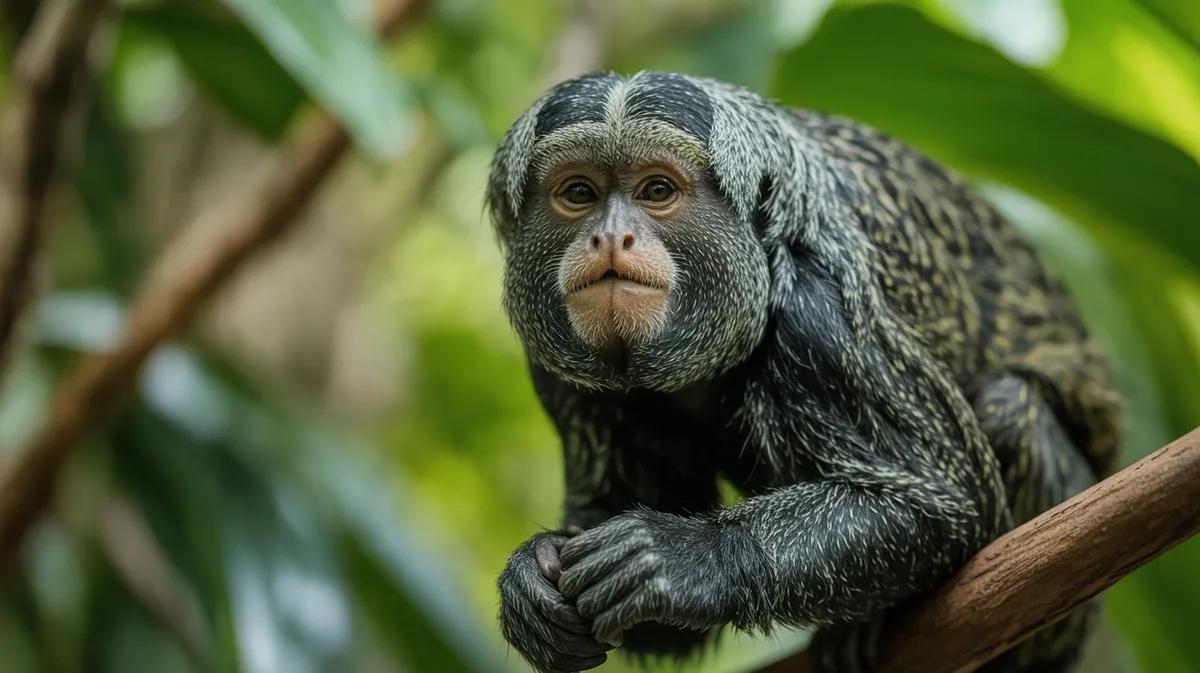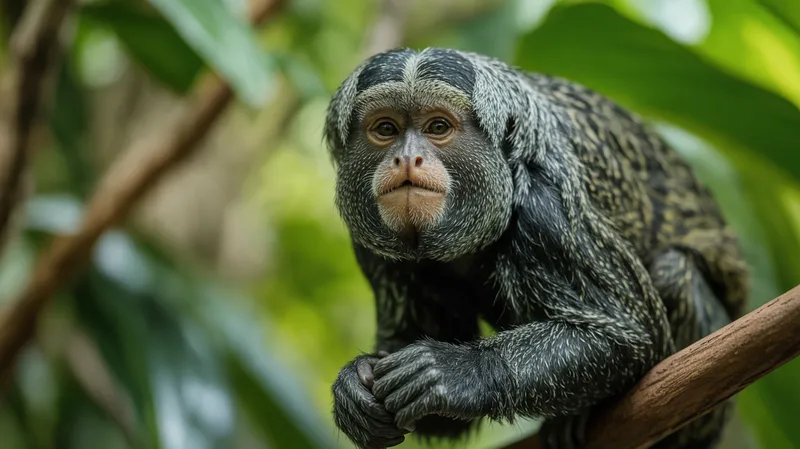
Saki Monkey
Pithecia pithecia

Meet the Saki Monkey
The saki monkey is a small to medium-sized primate native to the dense rainforests of northern South America. Recognized for their thick, shaggy fur and bushy tails, these monkeys are particularly notable for the striking facial coloration of males, which often contrasts sharply with their dark body fur. Saki monkeys are arboreal and highly agile, spending most of their lives leaping among the treetops in search of fruit, seeds, and insects. They are generally shy and elusive, living in small family groups and exhibiting complex social behaviors.
Classification
Mammal
Habitat
Tropical rainforest
Diet
Omnivore
Lifespan
15-30 years
Conservation
Least Concern
Weight
1.5-2.5 kg
📖Fascinating Facts
Expert Leapers
Saki monkeys can leap up to 10 meters (over 30 feet) between tree branches using their powerful hind legs.
Sexual Dimorphism
Males and females often have strikingly different facial coloration, with males typically displaying a pale or white face and females a more camouflaged, mottled appearance.
Fruit Lovers
Their diet mainly consists of fruit and seeds, but they also eat insects, small animals, and even flowers when available.
📋Detailed Description
The white-faced saki monkey (Pithecia pithecia) is a medium-sized New World primate distinguished by pronounced sexual dimorphism in facial coloration: adult males have a striking white or pale face contrasting with their black, shaggy body fur, while females and juveniles display more subdued, mottled brown and gray tones. Adults typically weigh between 1.5 and 2.5 kg, with a head-body length of 30–50 cm and a bushy tail nearly as long as the body, which aids in balance but is not prehensile. Their robust jaws and large, specialized incisors are adapted for cracking hard-shelled fruits and seeds, a dietary specialization among pitheciids. Saki monkeys are highly arboreal, rarely descending to the ground, and are known for their agile, bounding locomotion through the mid- and upper canopy. Social groups are usually small, consisting of monogamous pairs or nuclear families, although larger aggregations may occur around abundant food sources. Their vocal repertoire includes high-pitched whistles, grunts, and alarm calls, facilitating communication in dense forest environments. Sakis are diurnal, with peak activity in the early morning and late afternoon. Their home ranges vary from 2 to 10 hectares, depending on resource availability. Lifespan in the wild is estimated at 15–20 years, with individuals in captivity living up to 35 years.
💡 Did you know?
Despite their shy nature, saki monkeys communicate with a variety of vocalizations and even use facial expressions to maintain group cohesion.
🔬Research & Sources
Wikipedia Summary
Sakis, or saki monkeys, are any of several New World monkeys of the genus Pithecia. They are closely related to the bearded sakis of genus Chiropotes.
Last Modified: 5/26/2025
🎭Behavior & Social Structure
Saki monkeys exhibit a primarily frugivorous diet, with seeds, unripe fruits, and nuts forming the bulk of their intake, supplemented by flowers, leaves, and a variety of arthropods. Their powerful jaws allow them to exploit food resources inaccessible to many sympatric primates. Feeding bouts are interspersed with periods of grooming and rest, often in concealed positions to avoid predators. Social interactions are characterized by mutual grooming, vocal exchanges, and coordinated group movements. Territoriality is maintained through scent-marking and vocal displays, though direct aggression is rare. Sakis are cryptic and elusive, using rapid, bounding leaps of up to 10 meters between branches to evade threats. They maintain vigilance against aerial and terrestrial predators, such as raptors and felids, and will issue alarm calls when disturbed. Nocturnal resting sites are typically selected in dense foliage, providing camouflage and protection.
👶Reproduction & Life Cycle
The species is generally monogamous, with stable pair bonds maintained through grooming and close spatial association. Breeding can occur year-round, but peaks have been observed during the rainy season in some populations, likely linked to food abundance. Females give birth to a single offspring after a gestation period of approximately 150–180 days. Neonates are born fully furred and cling to the mother’s ventrum for the first few weeks. Parental care is predominantly maternal, though fathers and older siblings may participate in grooming and protection. Weaning occurs at 4–6 months, with juveniles reaching sexual maturity at 3–4 years. Interbirth intervals are typically 1–2 years, depending on resource availability and infant survival.
🛡️Adaptations & Survival
Key adaptations include robust, procumbent incisors and strong jaw musculature for processing hard seeds and fruits, a dietary niche that reduces competition with sympatric frugivores. Their cryptic coloration and shaggy pelage provide camouflage in the dappled light of the rainforest canopy. Long, bushy tails aid in balance during rapid, horizontal leaps. Behavioral adaptations include cryptic movement patterns, vigilance, and the use of concealed sleeping sites to minimize predation risk. Their complex vocalizations and olfactory communication facilitate social cohesion and territory maintenance in visually obstructed habitats.
🎨Cultural Significance
Saki monkeys are not widely featured in indigenous folklore compared to some other Neotropical primates, but they are occasionally referenced in Amazonian oral traditions as elusive, forest-dwelling spirits. In some local cultures, their distinctive appearance and secretive behavior have inspired taboos against hunting or disturbing them. They are sometimes kept as pets in rural areas, though this is discouraged due to their specialized needs and conservation concerns. Sakis are increasingly recognized as flagship species for rainforest conservation and ecotourism initiatives.
🔬Recent Research & Discoveries
Recent molecular studies have led to taxonomic revisions within the genus Pithecia, revealing greater species diversity and cryptic speciation than previously recognized. Ongoing research is focused on their ecological roles as seed predators and dispersers, with implications for forest regeneration dynamics. Behavioral studies using camera traps and acoustic monitoring are shedding light on their social organization, ranging patterns, and responses to habitat disturbance. Conservation genetics projects are underway to assess population structure and connectivity across fragmented landscapes. Notably, a 2014 revision by Marsh identified several new species within the genus, highlighting the need for further field surveys and taxonomic clarification.
🎥Wildlife Videos

Saki Monkeys | Animal Anthology Episode 03
Saki Monkeys | Animal Anthology Episode 03 Sakis, or saki monkeys, are any of several New World monkeys of the genus ...
Discovery Animal Planet

Mysterious Amazon Animal Seen for First Time in 80 Years | Nat Geo Wild
About National Geographic Wild: National Geographic Wild is a place for all things animals and for animal-lovers alike. Take a ...
Nat Geo Animals

Extremely Rare Monkey Species You Never Knew Existed
Some monkeys are cute. Others are clever. And then there are a few that look like they escaped from a dream… or maybe a ...
4 Ever Green

The Park's First Saki Monkey | Season 7 Episode 1 | Full Episode | Monkey Life
Monkey Life S07 E01 Full Episode: Alison and Jeremy welcome their first ever saki monkey to the park. Ring-tailed lemur Houdini ...
Monkey Life

Concerns Over Chimp Sally in Monkey Life | S11 E13, 14, 15 & 16 | Full Episodes
Monkey Life S11 E13, 14, 15 & 16 Full Episodes: Alison's on a mission to collect a marmoset found climbing scaffolding on a large ...
Monkey Life

What Are The Identifying Features Of A White-faced Saki Monkey? - South America Travel Pros
What Are The Identifying Features Of A White-faced Saki Monkey? Discover the fascinating world of the white-faced saki monkey ...
SouthAmericaTravelPros
🌍Habitat Information
The Saki Monkey typically inhabits Tropical rainforest environments. Saki Monkeys have adapted to their environments with specialized features and behaviors.
Primary Habitat:
Tropical rainforest
More detailed habitat information will be available soon.
🛡️Conservation Status
The Saki Monkey is currently classified as Least Concern. Conservation efforts are crucial for preserving this species for future generations.
Common Threats:
- 🏠Habitat loss and fragmentation
- 🌡️Climate change impacts
- 🎯Hunting and poaching
- 🏭Human-wildlife conflict
⚠️Threats & Conservation Challenges
While currently listed as Least Concern by the IUCN, saki monkeys face increasing threats from habitat loss due to logging, agricultural expansion, and infrastructure development in the Amazon basin. Fragmentation of forest habitats reduces genetic connectivity and exposes populations to edge effects and increased predation. Hunting pressure is generally low, as sakis are not a preferred target for bushmeat, but they may be captured for the pet trade in some areas. Climate change poses a long-term threat by altering forest structure and fruiting phenology, potentially impacting food availability. Population trends are poorly understood due to the species’ cryptic habits and the remoteness of much of its range.
🔬Scientific Classification
Scientific Name
Pithecia pithecia
Classification Hierarchy
🔍 About Taxonomic Classification
Taxonomic classification is a hierarchical system used by scientists to classify and organize living organisms based on shared characteristics and evolutionary relationships.
The system moves from broad categories (Kingdom) to increasingly specific ones, with each animal's scientific name typically consisting of its Genus and species.
📝Community Notes
Share your observations and insights about the Saki Monkey with our community of wildlife enthusiasts.
Join Our Community
Sign in to share your observations and connect with fellow wildlife enthusiasts.
Sign In to ContributeNo community notes yet
Be the first to share your observations about the Saki Monkey!
Explore Saki Monkey
Select a tab above to learn more about this amazing animal.
📸Photo Gallery
No photos available for this animal yet.
🌟Discover More Wildlife
Continue your journey of discovery with more fascinating animals from our database
